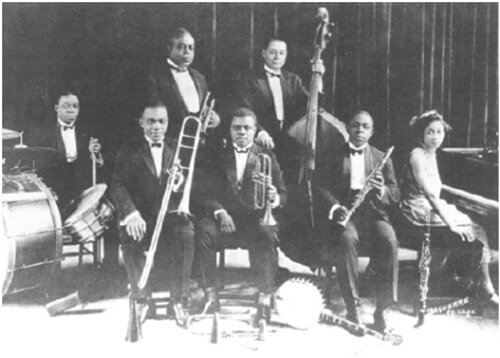African American Spiritual Historical Resources
The Popularity of Early Recordings of the Fisk Jubilee Quartet
Hall Johnson and the Emergence of Larger Mixed Professional Vocal Ensembles
Dawson and the Emergence of Large Mixed Choirs in the Historical Black Colleges
W.E.B.DuBois on the Spiritual, from "The Souls of Black Folk" (1903)
The Underground Railroad in Bucks County
Lourin Plant Article on Racial Barriers in Classical Vocal Music
A History of the African-American Spiritual
How the African-American Spiritual has maintained its integrity
in the face of major social and musical challenges
[Based on an article by Thomas Lloyd published in the August 2004 issue of the Choral Journal of the American Choral Directors Association; all rights reserved.]
8. Musical and Social Upheaval in the Jazz Age
Oliver’s Creole Jazz Band - 1923
The social and musical upheaval of the 1920s provided the greatest challenge the spiritual would yet face in maintaining its integrity while avoiding extinction. By the end of this period, it would find itself no longer sharing market space with the icons of American pop culture, but in exchange would reach safer and more permanent places to grow, in the concert hall and in the repertory of professional, school, church, and community choirs all over the world.
In the wake of the first World War, in which over 200,000 black men fought and served (including those in a number of outstanding service bands), the secular side of black folk music began to break the shackles of minstrelsy and strike out with an independence of its own. Black artists developed their folk music traditions in a way that caught the attention of the tune smiths of Tin Pan Alley and the leading modernist composers of Europe. What became known as "jazz" grew out of the emergence of ragtime, brass band music, syncopated dance music, and the blues.[1] Well suited to the energies of the age, this music was aggressive, sensuous, and the instruments of the band claimed center tage. The influence of the spiritual was not completely obscured by all this high energy,[2] but it was increasingly viewed by a younger generation as a musical relic of the past.
In the black churches, the spiritual had been almost completely replaced in worship by charismatic gospel music, which had come into its own by adapting the harmonies, rhythms, and instrumental accompaniments of the blues and jazz to the congregational lining-out of hymns that had continued since the Great Revival.[3] As demonstrated in recording sessions continuing into the 1920s, the Fisk groups firmly held the line against any encroachment by the newly popular styles, maintaining an unaccompanied vocal texture with subtly inflected melodies and straightforward harmonies.[4] But Tim Brooks has noted that even the leading black journals of the day (which usually made a point of celebrating black artistic accomplishment) such as The Freeman, the New York Age, and The Crisis (the journal of the NAACP) made little reference to the Fisk recordings, even in the years of their peak popularity.[5] By the end of the "roaring 20's," the male quartet had moved on from the spiritual to gospel, with groups such as the Dixie Hummingbirds, the Soul Stirrers, and Swan Silvertones.[6]
Notes:
[1]Southern 365ff.
[2]See James H. Cone’s penetrating look at the connections between spirituals and the blues, in The Spirituals and the Blues: An Interpretation (New York: Seabury Press, 1972).
[3]For a probing discussion of the relationship between the spiritual and gospel music, see Marvin V. Curtis, "African-American Spirituals and Gospel Music: Historical Similarities and Differences" in the Choral Journal 41:8, March 2001, 9-21. One important instance where the black church did not abandon the spiritual was in the "Wings Over Jordan" choir, founded by pastor Glenn T. Settle of Gethsemane Church in Cleveland, which broadcast a popular weekly radio show to the nation on CBS between 1939 and 1949, with breaks during the war to perform for the troops in Europe (Southern 423).
[4]Some purists of the style are concerned even today by some of the extended jazz harmonies such as those found in Larry Farrow’s arrangements and some of the gospel-inflected spirituals such as those of the late Moses Hogan, though others rejoice what they consider to be the renewing variety these and other recent composers have brought to the tradition.
[5]Brooks 299.
[6]Southern 483.

